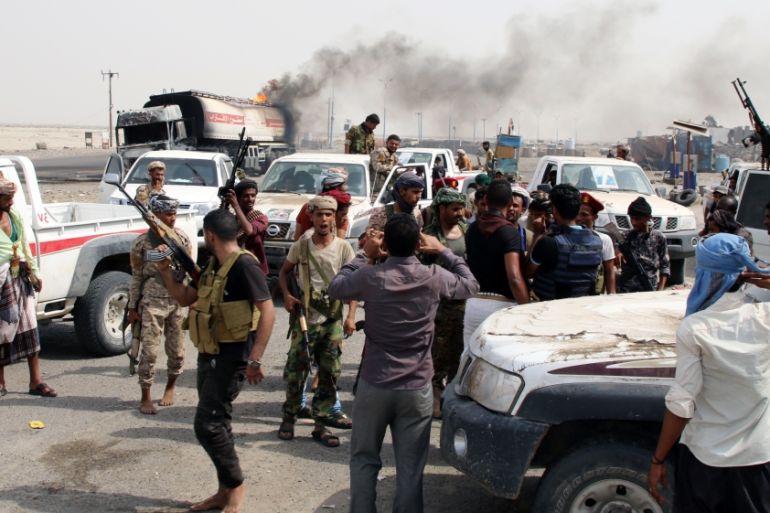Battle for Aden: Who is fighting who and how things got here
Clashes expose rift in Saudi-UAE coalition and open new front in war UN calls world’s worst humanitarian crisis.

Separatists from the Southern Transitional Council (STC) are part of a Saudi-UAE military alliance backing the forces of Yemen‘s internationally recognised government in their fight against the Houthi rebels, who control the war-torn country’s north.
But in a dramatic twist earlier in August, the STC forces took over the southern city of Aden, which has been the temporary base of President Abd-Rabbu Mansour Hadi‘s government since the Houthis seized Yemen’s capital, Sanaa, in 2015.
On Wednesday, government forces said they had recaptured the key port city, only to be pushed back by STC forces, which have been trained and equipped by the United Arab Emirates.
The situation remains extremely fluid, and both sides say they are now in control of different areas. The fighting, however, has exposed an apparent rift in the Saudi-UAE coalition and opened a new front in a war that the United Nations has called the world’s worst humanitarian crisis.
Here’s all you need to need to know about the violence gripping Aden and how things got here.
2017 tensions
The southern separatists and the coalition-backed government had been fighting side by side for years against the Houthis, but their relations have been strained over the past two years.
Tensions rose in April 2017 after Hadi sacked Aidarous al-Zoubeidi, the governor of Aden. In early May, thousands of Aden residents took to the streets to protest against Hadi, reviving the Southern Movement which calls for autonomy or secession for South Yemen, an independent state from 1967 until 1990, when it merged with North Yemen. Four years later, an armed secession bid failed to reverse the reunification.

Al-Zoubeidi formed the STC, a separatist-dominated parallel authority, on May 11, 2017, in a move that was denounced by the government of Hadi, who is based in Saudi Arabia.
Fighting between the two sides broke out in January 2018, with the separatist forces seizing almost all of Aden and surrounding the presidential palace. At least 38 people were killed in three days of fighting, before the Saudi-UAE-led coalition mediated to lift the siege.
The crisis exposed divisions between the two coalition’s two key members: Saudi Arabia, which backs Hadi, and the UAE, which supports the Security Belt, a paramilitary force dominated by STC supporters.
Aden seizure
On August 7, 2019, clashes break out again between the separatists and pro-government forces in Aden. The fighting erupts on the same day of the funeral of Munir “Abu al-Yamama” al-Yafei, a leading commander in the Security Belt.
Yafei was among dozens killed in a Houthi-claimed missile attack on a military parade in western Aden on August 1.
Members of the STC, however, accused al-Islah, a Yemeni affiliate of the Muslim Brotherhood, of being behind the attack and more broadly of acting in concert with the Houthis to destabilise southern Yemen.
This is even though al-Islah and the Houthis stand on opposite ends in the conflict pitting Saudi-backed, pro-government troops against the rebel group.
|
|
On August 10, the separatists gained ground across the city, saying they have seized the presidential palace.
The government accused the UAE of backing a “coup”, while the UN said 40 people were killed and 260 wounded in the four days of fighting.
Saudi Arabia and the UAE call for dialogue and send a joint military delegation in mid-August to defuse the crisis.
On August 17, STC supporters vacate some public buildings in Aden, but keep hold of military positions.
Three days later, Security Belt fighters surround a special forces camp in Zinjibar, the capital of Abyan province about 60km from Aden. Clashes also flare at a nearby military camp. A Security Belt commander says the force controls both sites.
Martin Griffiths, the UN’s special envoy to Yemen, warns the Security Council that “the fragmentation of Yemen is becoming a stronger and more pressing threat”.
‘Fragile situation’
On August 20, the Yemeni government said the UAE was “fully responsible for the armed rebellion”, a charge denied by Abu Dhabi.
On August 24, government troops took control of the city of Ataq in Shabwa province.
On August 28, pro-government forces said they had recaptured Abyan province, while Yemeni Information Minister Moammar al-Eryani announced that government forces had taken “full control” of Aden, including the presidential palace.
However, the next day, the separatists push back, helped by newly arrived forces from Hodeidah.
Meanwhile, Yemen’s government accused the UAE of launching air raids against its troops in support of separatist fighters, killing at least 30 people.
|
|
The aid charity Doctors Without Borders, known by its French acronym MSF, said it had taken in 51 casualties during heavy fighting in Aden on Wednesday, 10 of them already dead when they reached its hospital.
“It’s total chaos here. There was fighting in the city all day yesterday. Things appear to have calmed down a bit this morning, but we expect the hostilities to resume at any point,” MSF programme manager Caroline Seguin said in a statement.
The United Nations Office for the Coordination of Humanitarian Affairs (OCHA) in Yemen said 13 people were killed and at least 70 wounded over the past two days in Aden and Abyan.
“We mourn for the dead and wounded and plead with everyone who is fighting to respect their obligations under international humanitarian law,” said Lise Grande, humanitarian coordinator in Yemen.
“The situation is very fragile. Families are again trapped in their homes by fighting, unable to secure food and reach medical care,” said Grande, adding that “the timing couldn’t be worse”.